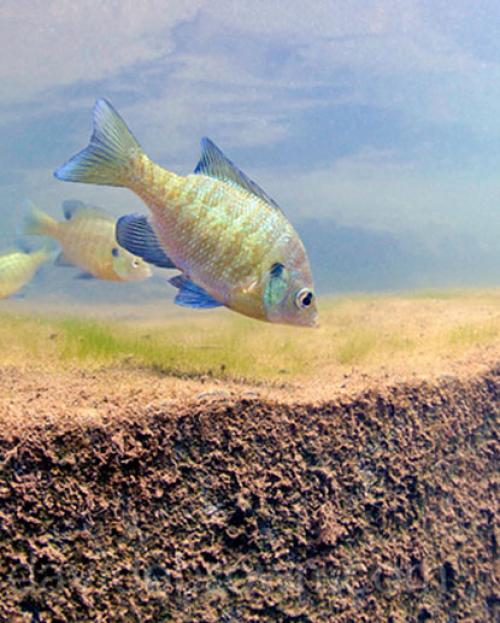David O. Brown '83 has filmed orca whales feeding on sharks and underwater lava flows. He traveled to Alaska just a few days after the wreck of the Exxon Valdez to document its impact on wildlife and worked for the Cousteau Society, visiting the most remote and animal-rich places on the planet.
"I love anything that moves," says the Ithaca native, who's now returned to his hometown to create the film company Amphibious Films. "What makes me happiest is being close to a creature in its environment doing what it's supposed to be doing."
While Brown still travels the globe for many of his projects, one close to his heart finds him diving around his boyhood waterways.
Brown has been exploring the depths of the Finger Lakes and local streams for "Baseline," a project cataloging the health and biodiversity of the area's waterways ahead of potential changes from hydraulic fracturing, as well as the continued intrusion of invasive species.
"To trade fresh water for fossil fuels is irresponsible because our climate is changing so much," Brown says. "We don't know what our water supply will look like in 10 years."
Brown's project is the first to compile comprehensive footage of local waterways and endemic creatures such as sturgeon, salamanders, bowfin, lake trout and salmon. Through his underwater filming expeditions, he's discovered rich ecosystems in lakes like Skaneateles Lake, which is fiercely protected as part of the city of Syracuse's water supply, but also fragile damaged areas like the Cayuga Inlet south of the city of Ithaca, where development has turned wetland areas into parking lots.
Still, "Ithaca has managed to hold on to a lot of wonderful wild areas," he says. "I would love it if my kids could grow up and find all of this largely intact."
The footage from the Baseline project -- which is supported by the Park Foundation and a $10,000 grant from Toyota and the National Audubon Society's TogetherGreen program -- is available free to schools, nonprofits and environmental organizations. It is coupled with water quality data collected by the Finger Lakes Institute and disseminated through presentations and short films.
Brown, a history major at Cornell, said his father, Theodore M. Brown -- a Cornell professor of architectural history and also an avid photographer -- first turned him on to film.
Brown chose history because Cornell's program offered a great deal of flexibility while providing a solid grounding in research and critical thought. He also took film classes and was influenced by his undergraduate adviser, Will Provine, professor emeritus of ecology and evolutionary biology, who inspired him to delve deeply into the many ways science may be influenced by societal matrices and economic concerns.
Following his junior year at Cornell, Brown spent the summer as the only non-biology major taking photographs and studying whales in Gloucester, Mass., as part of a team founded by Mason Weinrich '82 -- the first of four field seasons he spent studying and photographing whales.
"I'd always been fascinated by the ocean, but that was my first job on the water," he says.
Brown also is at work on a collaboration with Robin Hadlock-Seeley (assistant director for academic affairs at Shoals Marine Lab and a Cornell senior research associate) of the Rockweed Coalition to document the effects of the harvest of rockweed along Maine's shoreline. He is also working with Cornell professor and marine biologist Drew Harvell, searching the oceans for footage of the actual sea creatures featured in Cornell's glass Blaschka Invertebrate Models, the work of famed 19th-century glass artists Leopold and Rudolf Blaschka.
After years of adventure and discovery underwater, Brown is focusing his skills on one purpose -- raising awareness of the natural world.
"Most people think in pictures," he says. "You can talk all you want about the beauty of the outdoors, but when you see what it actually looks like under the surface of any healthy water system, you understand how important it is to protect these areas."
To learn more or view photos from Brown's expeditions in Ithaca and afar, visit www.davidobrown.com.
This story first appeared in Ezra Update.




